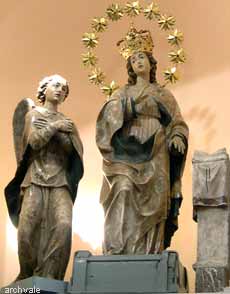The Annunciation Feast
 The cult of Mary in Bronte explodes in August in the centuries-old feast of Maria Santissima Annunziata, Patron of Bronte, that throughout the centuries has protected the town from the lava flows and from the devastating fury of Etna. The cult of Mary in Bronte explodes in August in the centuries-old feast of Maria Santissima Annunziata, Patron of Bronte, that throughout the centuries has protected the town from the lava flows and from the devastating fury of Etna.
The brontese people is devoutly tied by feelings of ancient and profound religiosity to their patron saint to whom many times has prayed so that she would placate the destructive fury of Etna. The cult and devotion of Bronte to the Madonna has ancient origins: the Annunciated church existed already before the unification of the 24 Farm-houses. And it was in this occasion (1535 - 1548), that, by order of Carlo V, all the settlements and farmhouses had to be united in the ancient Bronte, that the church was rebuilt and enlarged, and, after the arrival of the statue towards 1543, the rising new city was put under the protection of the Annunciated Lady, giving to the inhabitants that had been, until then, spread in the old settlements, a new common identity. From 1821, in the month of August, with great fervor and participation, the marble group of the Virgin Annunciated and the Angel Gabriel (work by A. Gagini preserved in the church of the Annunciated) is brought in procession in the streets of Bronte, over a wagon trained by oxen. Tells the legend of the "barter" and of the "journey" of the statue of the Annunciated to Bronte and of the "new identity" that the inhabitants of the 24 Settlements found in their Lady Protector. The wagon and the oxen respect the tradition that reports as the Virgin statue "Was bartered by Greek pirates to some brontese shepherds with some "albaggio" (rustic drape that was made then in Bronte).
These shepherds asked a gentleman for a pair of bulls to transport the two statues to Bronte.  He gave them two wild, indomitable bulls that, seeing the Virgin, bended down and let themselves be meekly subdued; along the way the forest trees stood aside to the passage of the wagon. He gave them two wild, indomitable bulls that, seeing the Virgin, bended down and let themselves be meekly subdued; along the way the forest trees stood aside to the passage of the wagon.
Arrived in Bronte the oxen made a circle as to mark the site where had to rise, more grandiose, the temple".
(Benedetto Radice, "Chiese, conventi, edifici pubblici in Bronte", Bronte 1923). A characteristic and touching moment of the procession is the reconstruction of the Annunciation with the flight of the angel ("a burata 'el’Angilu", see the web page in Italian). The statues (Mary and the Angel) are placed at the center of Spedalieri square and a child, dressed as the angel Gabriel, reaches slowly the Virgin from the sky, sliding along a steel rope whose extremes are attached to two, close by palaces. The Virgin Mary is there, dressed with all the gold given to her, during the centuries, by the faithful brontese citizens, while the Angel comes down in front of her, recites the Ave Maria, to announce the miracle of the birth of Christ and offers her a Lily.
|